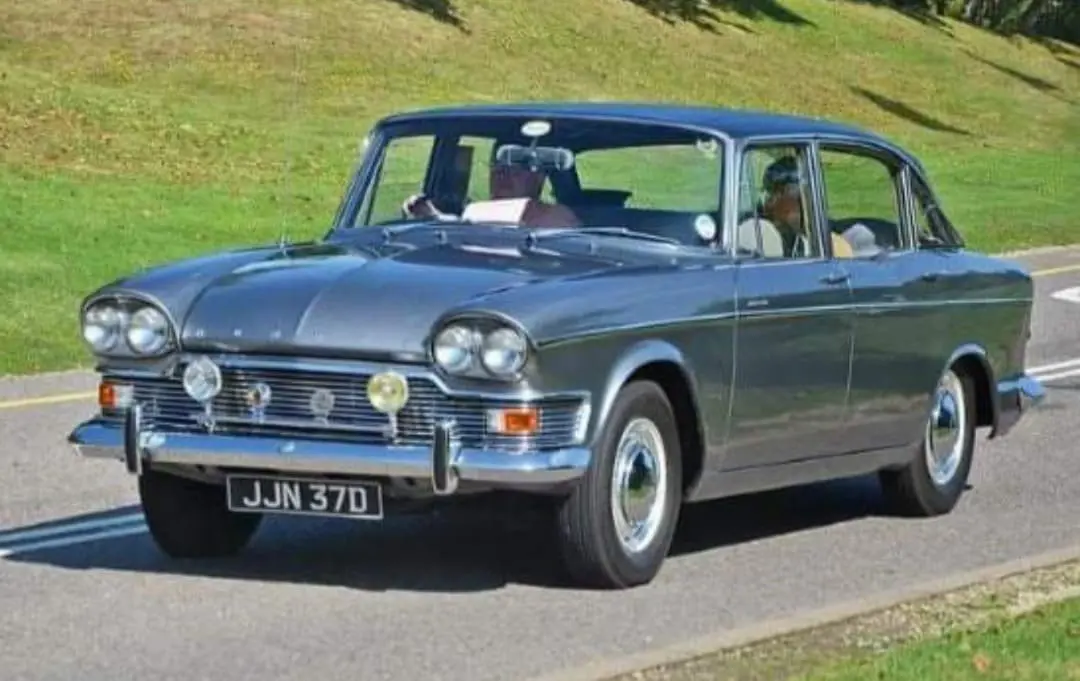MEET THE OWNER – STEPHEN LEWIS AND HIS HUMBER IMPERIAL
26 April 2022
If you owned a new Humber Imperial in 1966, you were almost certainly one of the elite members of your local tennis club. Not only was it a car as imposing as James Robertson Justice in Doctor in Clover, but the list of standard fittings was also positively lavish. In addition to power-assisted steering and automatic transmission, there was also three cigar lighters; two for the rear passengers who also benefited from picnic tables, a second heater unit and adjustable reading lamps. A nylon rug covered the pile carpets, and the specification further included an MW/LW radio with speaker balance, ‘Selectaride’ adjustable rear dampers controlled from a dashboard-mounted knob, red warning lamps for when the doors opened, reclining front seats, with height adjustment via a spanner and a rear screen demister operated by a switch mounted by the driver’s door.
The Imperial customer could also choose between West of England cloth or leather upholstery. The flagship Humber was immediately recognisable via its fog and spot lamps and vinyl-covered roof. And the custodian of the magnificent JJN 37 D is Stephen Lewis, the Historian for the Post Vintage Humber Car Club and the author of a book on post-war Humbers from Amberley Publishing.

The ’Series’ family commenced in 1957 with the ‘New Hawk’ launch, followed by the six-cylinder Super Snipe in 1958. The Rootes Group unveiled a facelifted range at the Earls Court Motor Show six years later. ‘Three Window styling replacing the familiar ‘dog’s leg’ windscreen and curved screen. The Snipe’s 3-litre engine now featured twin Zenith Stromberg 175CD carburettors and a Weslake cylinder head. There was also a new flagship model with coachwork by Thrupp & Maberly of London. The advertisements promised “A new conception of executive luxury”, and the flagship Humber provided elegant transport for £1,795 18s 9d. This price was considerably lower than a Jaguar Mk. X and well below the £2,000 threshold for claiming tax relief on a ‘business car’.
As for the press reaction, Motor Sport mused “whether this latest Humber Imperial will find favour in St. James’s I do not know, but certain it is that amongst financially shrewd industrialists, such as abide in the busy Midlands and elsewhere, this is a car the quality-for-outlay of which should exert a strong appeal”. Meanwhile, an Autocar test employed slightly less snobbery. It concluded, “For the man who wants distinction and needs to carry several passengers in real comfort and quietness at quite high cruising speeds this car could well be a complete answer”. Rootes also gained invaluable publicity when Harold Wilson used an Imperial during his first term as Prime Minister.
The end came in 1967 when the parent company Chrysler cancelled the promising V8 engine replacement. Instead, Ryton developed a ‘C-Class’ model scheduled for launch in 1970, with Australian-imported Valiants as a stop-gap measure. Alas, Highland Park eventually decided the eventual 180/2-Litre would wear the Pentastar badge instead of separate Hillman, Sunbeam and Humber logos. Today JJN is a fascinating reminder of the last days of the Rootes Group, and perhaps its most abiding image is the handsome example in the 1968 spy thriller A Dandy in Aspic. An Imperial + Laurence Harvey = cinematic decadence. As for the Lewis Humber, its proud owner explains:
To drive, you are ‘wafted’ along. With well-sprung cloth seats, good sound insulation, and a 3-speed automatic box that invariably always pulls away in 2nd straight to 3rd, that’s it! However, with the power steering, you can easily drift off if not careful!! An armchair on wheels”. Steven came by the Humber in September 1997 - “regrettably, the previous owner had passed away. A millionaire businessman in Westcliff on Sea in Essex originally commissioned the Humber and registered it on 14th October 1966. On his passing, the Imperial was put into storage for six years before the next owner purchased it in 1984, giving it a sympathetic respray and some other work but it was basically in excellent original condition. The car became well known in Humber circles”. Over the past 25 years, Mr. Lewis has carried out a running restoration, and the Humber has now covered some 64.000 miles.
And it more than fulfils the Rootes Group’s promise of – “fully equipped for supreme luxury”.
With Thanks To – Stephen Lewis and The Post Vintage Humber Car Club
